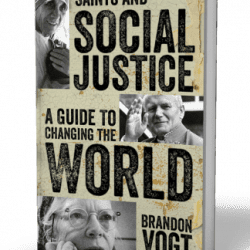 Sergius Bulgakov. Relics and Miracles. Trans. Boris Jakim. (Grand Rapids, MI: William B. Eerdmans Publishing Company, 2011).
Sergius Bulgakov. Relics and Miracles. Trans. Boris Jakim. (Grand Rapids, MI: William B. Eerdmans Publishing Company, 2011).
Boris Jakim has done it once again. He has expertly translated two shorter works of Sergius Bulgakov – “On Holy Relics” and “On the Gospel Miracles.” Both of these essays contain significant theological reflections which transcend their length, giving us an example of the kind of synergia Bulgakov saw behind any miracle. In this way, the book itself is a little miracle of teaching, providing to us significant theological reflections which are as relevant today as they were when Bulgakov wrote them.
“On Holy Relics” came as a response to the mockery of holy relics which Orthodox Christians witnessed done by the communists. There was, in part, a false theology of holy relics which encouraged such a response: it was the assumption that the physical corpse of a saint should remain perfect and incapable of harm. Communists thought they were proving the Orthodox faith wrong by their desecrating the tombs of the saints: look here, this saint is rotting, look here, this saint’s body is easily destroyed.
But, as Bulgakov points out, while the holy relics of the saints can be said to be protected by Christ, those relics are not exactly one and the same as the physical corpse. “In general, one must reject the notion that holy relics have inalienable physical attributes; such do not exist” (6). Yes, their remains deserve respect, and it is an authentic Christian practice to show reverence to the bodies of the saints:
If the saints are holy, then their remains – their relics – are holy too; and these remains must be reverently preserved and venerated; in them and through them we address the glorified saints; by kissing them, we show our love for these saints. All that is human is not spiritual in the anticosmic sense; rather, it is cosmic, incarnate, has flesh, but this flesh is not dead matter, for it is permeated and sanctified by spirit, and this is why all sacraments, inasmuch as they are human, have, for man, matter and body – they are cosmic, they are human (9-10).
It is wrong to confuse these physical bodies as the inalienable bodies of the saints. “First of all, the remains are not, strictly speaking, the holy relics themselves; they are rather, so to speak, the place of the relics, their external shell, or not even a shell, but a cover” (30). They remain connected to the physical body, so that the body is indeed important, but the relics are the transfigured nature of the body, already experienced by the saint, and they are connected to us through the physical shell of the saint showing us the saint at the moment of their death. This indicates that the physical remains are important (and sometimes, can also be inviolate because of their connection to the saint) because they bring us in contact with the saint themselves, whose spiritualized life still connects them to their physical remains. But it is like an icon, and it can be harmed and destroyed like icons, bringing the connection we have with the relics of the saints to an end, but it does not, in the process, harm the transfigured life of the saint.
For Bulgakov, all of this flows from the incarnation, from the work of Christ in the world. The physical world is connected to the spirit, and the incarnation brings grace into the world through a physical means. This provides a foundation for Bulgakov to explore the sacraments and especially the eucharist, where he provides a significant explanation for his understanding of the eucharist. The physical properties of the eucharist are the properties of bread and wine, but the reality of the eucharist transcends their physical form.
The bread and wine are no longer bread and wine; they are transmusted into the Body and Blood of Christ, while preserving the external appearance and physical properties (color, taste, aroma, weight, etc.), of the bread and wine. The miracle of the Holy Eucharist, the love and divine condescension, are such that they preserve the properties that usually belong to bread and wine. The bread and wine can spoil, so special care must be taken to preserve the Holy Gifts undamaged; in other words, the holiest of all sacraments and transmutation by the Holy Spirit do not offer protection against the forces of natural destruction, against the action of the laws of the physical world (32).
In this way, just as the eucharist can suffer physical effects even if the substance is unaffected, one can understand the relationship between the physical bodies of the saint and their holy relics. Their body is the physical manifestation of the saint, the remains of that physical body, as pure body without spirit, but there remains, behind the physical appearance, the inviolate transfigured life of the saint. It is also in and through Christ’s body being placed in the grave that the holy relics find their connection with Christ.
There is, in Bulgakov’s analysis of holy relics, significant theological development going on which transcend relics. We are within the mystery of Christ, and we see a strong affirmation of the world contra any gnostic dualism (a dualism which, at times, can be found in Bulgakov’s own theological explorations). It is in this light, we should also see and understand Bulgakov’s exploration of miracles in the second essay of the book. Nature is preserved in miracles, not contradicted; it might be encouraged to be more fruitful, because grace perfects nature, but the order of nature itself, created by God, is not violated by God. Miracles come as the graceful reinforcement of nature, and not as some ignoring of nature in a deus ex machina act. For Bulgakov, the Chalcedonian definition of Christ shows us how God and created nature work together, not apart, and miracles are to be understood with a similar synergy:
The character of miracle consists not in causelessness or supracosmicity, but only in a special causality; and in the final analysis, in relation to the cosmos, miracle must be judged to be natural, not supernatural and especially not unnatural. In other words, miracle refers not to the creation but to God’s Providence for the world. But God as Providence acts in the world not be coercing it, not by correcting or changing the principles of its being, but only by guiding, through spiritual causality, the world’s natural, or mechanical (so to speak), causality. This union of spiritual causality (through freedom) and mechanical causality (through necessity) is what constitutes the character of the law governing the cosmos (52).
The rest of Bulgakov’s exploration of miracles follows through this principle, and explores the meaning behind it. God created the world to follow a certain way of being, and so does not contradict that creation. God works in and with the order of being, allowing us to work with and unite with him. This is the foundation of miracles. The miracles of Christ show the height of human possibility – indeed, the fact that they can be seen accomplished by other saints shows the human character behind such miracles. They are, of course, perfected in Christ, but their perfection is still human perfection and human work and is something which the saints, in performing miracles, attain. “In their content miracles are works of love and mercy; in their significance they are manifestations of human power in the world, human power that is reinforced and illuminated by God’s power. Being divine according to inspiration and providential will, miracles are human works, performed within the limits of the world and humanity” (78).
Bulgakov provides examples of great works performed through the saints which are the same works Christ accomplished, from healing of the sick, to the multiplication of food, to the resurrection of the dead. These works are done by Christ because they are human works, and they represent the expectation of humanity in the world. In this way, Bulgakov says he can accept Fedorov’s project — Christ told us that what he did, we should do, and so it is not just a description of what will happen, but Christ’s own expectation on us. It requires the unity of the spirit and spiritual reality with the physical world, and so Fedorov must not be read in a purely materialistic sense, but the project which is fundamentally Christian and incorporates, not denies, the spirit.
Bulgakov explores these themes in great detail, providing for a very strong presentation of what it means to be deified in Christ. The work is a significant, and relevant, text on how we can and should understand the miraculous, one which reminds us such presentations must always look at how grace relates to nature, where nature is never annihilated by perfected from within.
Both essays are masterpieces of Bulgakov’s theology and provide a significant understanding behind the themes of his Christology. They show a profound interest in preserving the world against all Gnostic dualism, but more importantly, they present a significant development on theological concepts which answer rationalistic reductionism and point out why such reductionism fails to meet the Christian faith.
This is a very recommended book.












